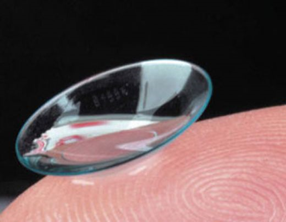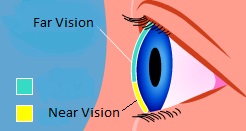Introduction
Presbyopia is a type of refractive error that happens as a result of changes in age or aging. It occurs due to the loss of ability to focus the eyes at close range. It is not a disease,usually starting at the age of 40 and above, and experienced by all individuals. It is different with nearsightedness (hyperopia), as nearsightedness occurs when the shape of the eyeball or the eyes’s refractive ability causes light to focus behind the eye.

Figure 1: The Normal Eye And Presbyopia
Symptoms And Signs Of Nearsightedness
- Difficult to focus on writing or small objects at close range
- Eyestrain especially when reading for long periods
- Need brighter lighting
- Need to hold reading materials further away from the usual distance
- Easily tired when doing close work
- Headache
- Double vision (diplopia)
Uncorrected presbyopia can disrupt patients’ daily activities. The effects differs among individual depend on near task demand. It is a condition that can be corrected by several methods, such as:
- Spectacles
- Contact lenses
- Combination of glasses and contact lenses
- Refractive surgery
- Multifocal intraocular lens implants

Contact Lens To Correct Presbyopia
In this modern and active lifestyle, most presbyopic still do a variety of daily activities which requires optimal vision to see at near and far distances. Therefore, contact lenses are an ideal choice for those who want to be free from spectacles. Contact lenses also provide a wider field of vision. Contact lenses are small plastic or silicone discs placed on the cornea to correct refractive error.These contact lenses are available in soft contact lenses and hard contact lens (rigid gas permeable lens). There are several types of contact lenses to correct presbyopia, which is:
- Contact lenses and single vision glasses for reading
A combination of contact lenses and single vision reading glasses to provide optimum vision for long distance and near, easy to use and less expensive.
- Monovision lens
Single vision contact lens used in each eye or no distance correction is required, a lens in only one eye. The dominant eye is generally corrected for distance, and the fellow eye used for near. The advantages of monovision are easy to fit and cheaper cost for one lens. Some patients may complaint of reduced stereopsis or spatial disorientation
- Bifocal Contact lenses
Two powers in one lens is placed in the pupil (pupil) that allows light from near and far focused on the retina . This lens option will provide clear vision for distance and near. But, it is not suitable for patient who require good vision for intermediate distance.
- Multifocal contact lenses
The power change gradually from distance part to reading part. Multifocal lens provide good vision at various distances from far, intermediate and near.

Can Diabetics Wear Contact Lenses?
There are studies showed that people with diabetes may experience a change in the chemical composition of tears, tear production, and changes in the structure and function of the corneal epithelium, corneal endothelium and nervous. They can also suffer from tears instability, discomfort while wearing contact lenses, corneal edema, corneal epithelial cells insensitivity and easily wounded. Thus, diabetic patients are more susceptible to ocular complications such as infection or injury to the cornea. However, there are study shows diabetics can still wear contact lenses safely if they follow the suggested wearing hour, proper lens care and handling. They also need to keep their blood sugar levels well controlled and always come for follow-up examination as advised by their eye care personnel.
Can Dry Eye Patients Wear Contact Lenses?
The eyes will become dry as our age increased due to decreases tears production and this will cause discomfort when wearing contact lenses. However, the proper choice of material appropriate wearing schedule, use of proper lubricating and solution drop, patients with dry eye can still use contact lenses. But there are also studies that show the use of contact lenses may cause dry eyes worsen where patients will experience discomfort and irritation, increase the risk of infection and protein deposits. Therefore, a thorough examination should be done by ophthalmologist or optometrist before consider contact lenses as an option to correct presbyopia.
Conclusion
The use of bifocal contact lenses and multifocal to correct presbyopia is an option for those who lead an active life and want to be free from the use of glasses. Before using contact lenses, patients should get a comprehensive eye examination by an expert ophthalmologist or qualified optometrist to ensure ocular health and suitability to wear contact lenses. Users must takes proper care of their eye health to avoid infection or unwanted problems. Proper lens care, handling instructions and proper eye drops should be stressed to overcome the problem of dry eye and infection. Immediately seek treatment if you are having red eye, pain or irritation during or after contact lenses use.
References
- http://www.aoa.org/documents/optometrists/CPG-17.pdf
- O’Donnell C & Efron N (2012) Diabetes and contact lens wear [Electronic Version]. Clinical & Experimental Optometry, 95.3, 328-334
- S Bennett E (2008) Contact lens correction of presbyopia [Electronic version] Clinical & Experimental Optometry, 91.3, 265-276
- http://www.gpli.info/pdf/Rx4Success-AnswerstoFrequentlyAskedQuestions.pdf
- http://www.dryeye.org/what.htm
- https://myhealth23.primuscore.com
- http://www.allaboutvision.com
| Last Reviewed | : | 17 Oktober 2016 |
| Writer | : | Pn. Majidah Binti Zainal Abidin |
| Translator | : | Pn. Majidah Binti Zainal Abidin |
| Accreditor | : | Pn. Rosmawati Binti Uthman |







